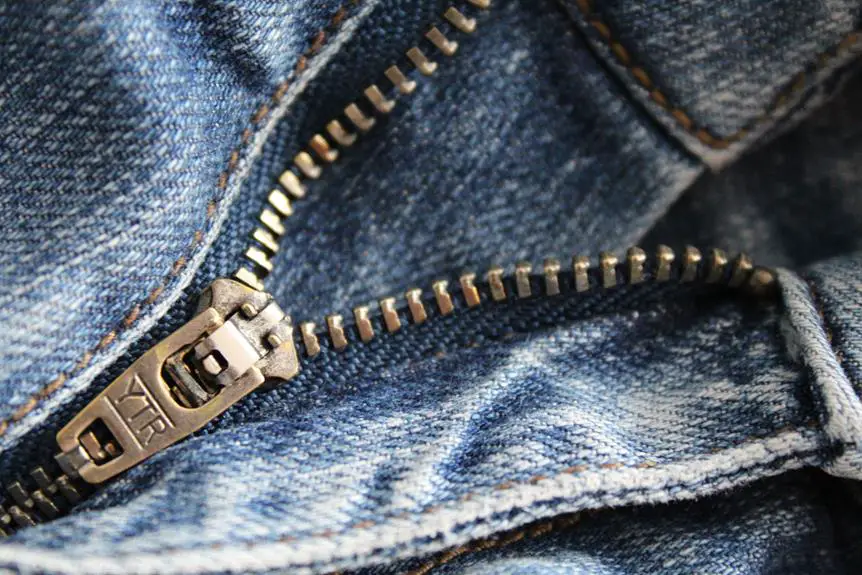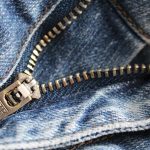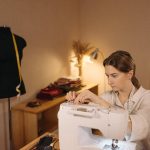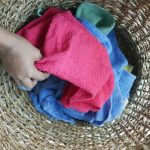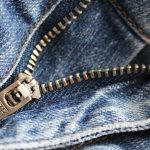You've mastered the art of sewing, but do you know the different types of fabric seams? Understanding the various seam options can take your sewing projects to the next level.
From the versatile straight seam to the durable flat-felled seam, each type serves a specific purpose in garment construction.
The zigzag seam is perfect for stretchy fabrics, while the elegant French seam provides a clean finish for delicate materials.
If you're looking for a professional touch, the overlock seam is your go-to choice.
And don't forget about the mock flat-felled seam, which mimics the look of a traditional flat-felled seam with less effort.
With these seam options in your repertoire, your sewing skills will reach new heights.
Key Takeaways
- Straight Seam and Zigzag Seam are versatile stitching techniques used in garment construction, offering decorative options and enhancing quality and aesthetics of sewing projects.
- French Seam, Flat-Felled Seam, and Mock Flat-Felled Seam provide neat and durable finishes, add elegance to sewing projects, and enhance the quality and durability of creations.
- Overlock Seam is perfect for preventing fraying and creating a neat edge on fabric, especially for knit fabrics and larger seam allowances.
- Lapped Seam is commonly used in garment construction, providing a strong and durable seam, while lapped seams and mock flat-felled seams are great choices for denim, offering enhanced durability, aesthetic appeal, and preventing fraying.
Straight Seam
The straight seam is a simple and versatile stitching technique that's commonly used in garment construction and sewing projects. When sewing a straight seam, it's essential to pay attention to the seam allowance, which is the distance between the seam and the raw edge of the fabric. The standard seam allowance is 5/8 inch, but it can vary depending on the specific project and personal preference.
After sewing the straight seam, it's crucial to finish the raw edges to prevent fraying. There are various seam finishing techniques such as zigzag stitching, serging, or using pinking shears. These techniques not only prevent fraying but also give a neat and professional look to the finished garment.
Additionally, the straight seam offers various decorative options such as topstitching or decorative stitching, which can add visual interest to the seam. By mastering the straight seam and exploring different seam finishing and decorative options, you can elevate the quality and aesthetics of your sewing projects.
Zigzag Seam
When sewing a zigzag seam, you'll use a back-and-forth stitching technique to create a flexible and stretchable seam that's ideal for stretch fabrics and preventing fraying. Zigzag stitching is a versatile fabric finishing technique that provides strength and elasticity. Here's what you need to know about it:
- Preventing Fraying: Zigzag seams are excellent for preventing fraying in fabrics, especially those prone to unraveling, such as knits and woven fabrics with a looser weave.
- Stretch Fabrics: This type of seam is well-suited for stretch fabrics like spandex and jersey, as it allows the seam to stretch with the fabric without breaking.
- Decorative Element: Zigzag stitching can also be used decoratively, adding visual interest to garments or home décor items. It provides a unique, textured look to the seam.
- Seam Reinforcement: When sewing garments that will undergo a lot of movement, such as activewear or dance costumes, a zigzag seam can reinforce the construction and durability of the garment.
Mastering the art of zigzag stitching and incorporating it into your fabric finishing techniques will enhance the quality and durability of your sewing projects.
French Seam
If you have mastered the art of zigzag stitching, you can now expand your repertoire by learning about the French seam, a versatile and elegant sewing technique that provides a neat and durable finish to your projects.
The French seam is a double seam that encases the raw edges of the fabric, giving a professional look while also preventing fraying. This type of seam finishing is particularly useful for lightweight and sheer fabrics, as it eliminates the need for additional seam finishing methods like serging or overlocking.
One of the key benefits of a French seam is its ability to create a clean and polished look on the inside of the garment, making it ideal for garments where the inside is visible. Additionally, the French seam can also be used as a decorative element or for fabric manipulation, adding a touch of elegance to your sewing projects.
Flat-Felled Seam
Looking to add strength and durability to your sewing projects? Try using a flat-felled seam, an effective and versatile technique for securing fabric edges. This type of seam is commonly used in garment construction and is known for its neat appearance and strong hold.
Here's why you should consider incorporating flat-felled seams into your sewing repertoire:
- Strength: Flat-felled seams are incredibly sturdy, making them ideal for heavy-duty fabrics and items that will undergo a lot of wear and tear.
- Durability: By encasing raw edges within the seam, flat-felled seams prevent fraying and provide a long-lasting finish, perfect for garments and home decor items.
- Professional Look: This seam creates a clean and polished look on both the inside and outside of the fabric, giving your projects a professional touch.
- Versatility: Flat-felled seams can be used in a variety of sewing techniques and fabric finishing, making them a valuable skill for any sewing enthusiast.
Incorporating flat-felled seams into your sewing projects can elevate the overall quality and durability of your creations while adding a professional touch to your finished pieces.
Overlock Seam
How can you create a secure and professional fabric edge using an overlock seam?
An overlock seam is a type of seam finishing technique that's perfect for preventing fraying and creating a neat, clean edge on your fabric. It's commonly used on knit fabrics, but can also be used on woven fabrics with seam allowances of ⅝ inch or more.
To create an overlock seam, you can use a serger machine with multiple threads and loopers that trim the fabric edge and encase it within the serged stitches, creating a secure and professional finish. The overlock seam not only provides a clean edge, but it also adds strength to the seam, making it ideal for garments and other fabric projects that require durability.
When working with an overlock seam, it's important to pay attention to the seam allowances. Make sure that the seam allowances are accurately trimmed and enclosed within the overlock stitches to prevent any fraying or unraveling of the fabric.
Mock Flat-Felled Seam
When sewing, you want sturdy seams that can withstand wear and tear.
The mock flat-felled seam is a great choice for this, as it provides extra strength to the garment construction.
This type of seam is particularly ideal for denim and heavy-duty fabrics.
Strengthens Garment Construction
To strengthen garment construction, you can use the mock flat-felled seam, a durable and professional-looking sewing technique. This method enhances the durability of your garments and gives them a polished, high-quality appearance. Here's how the mock flat-felled seam strengthens garment construction:
- Double Stitching: The mock flat-felled seam involves two lines of stitching, significantly reinforcing the seam.
- Clean Finish: It provides a tidy and neat finish on both the inside and outside of the garment, ensuring no raw edges are exposed.
- Sturdy Seam Allowances: This technique involves overlapping fabric edges, creating strong, secure seam allowances.
- Ideal for Heavy Fabrics: It's particularly useful for heavyweight fabrics and denim, making it perfect for sturdy and long-lasting garment construction.
Ideal for Denim
If you're working with denim, the mock flat-felled seam is an ideal choice for its durability and professional finish. This type of seam is perfect for distressed denim, as it adds strength and a clean look to the garment.
The mock flat-felled seam is achieved by sewing one piece of fabric on top of the other, then topstitching the top piece to secure the seam allowance underneath. This creates a neat, flat appearance on the outside of the garment.
It's also great for denim with a raw hem, as it encases the raw edges, preventing fraying and ensuring a polished look.
When working with denim, especially distressed styles or raw hems, the mock flat-felled seam is a top choice for both strength and aesthetic appeal.
Frequently Asked Questions
Can Fabric Seams Be Used to Create Decorative Elements in Clothing and Home Decor Items?
Fabric seams can be used for creative applications, adding decorative elements to clothing and home decor items. Explore design possibilities with fabric seam embellishments to elevate your projects and bring unique flair to your creations.
What Are the Best Types of Fabric Seams to Use for Stretchy or Delicate Fabrics?
For stretchy or delicate fabrics, the best seam types are zigzag, overlock, and French seams. These sewing techniques allow for flexibility and durability. Use stretch stitches and pinking shears for finishing methods to prevent fraying.
Are There Any Specific Sewing Techniques or Tools That Can Help to Create Stronger and More Durable Fabric Seams?
To create stronger and more durable fabric seams, you can use sewing techniques like backstitching or topstitching. Reinforce seams with tools like seam rollers or hammers. Consider decorative elements like piping for both style and added strength.
How Can Fabric Seams Be Finished to Prevent Fraying and Ensure a Professional-Looking Final Product?
To prevent fraying and achieve a professional finish, consider using decorative elements on fabric seams. Trim, bias binding, or overlocking can add durability and a polished look to your final product.
Are There Any Common Mistakes or Pitfalls to Avoid When Sewing Different Types of Fabric Seams?
When sewing different types of fabric seams, common mistakes like using mismatched fabrics and improper cutting can lead to issues. Proper technique is crucial for a polished finish, so pay attention to these details.
- Which Side of the Gore-Tex Fabric Is Waterproof? - July 2, 2025
- When Should You Replace Your Gore-Tex Hiking Boots? - July 2, 2025
- When Does the Gore-Tex Patent Expire? - July 2, 2025

